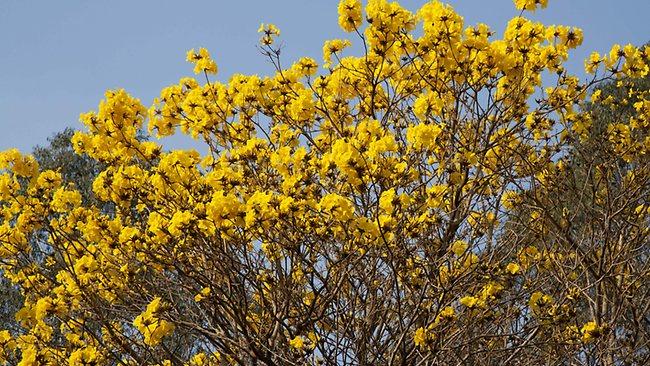Hot coloured borders and beds
IN a country of clear blue skies such as we enjoy for many months of the year in Australia, discreet colours can sometimes look insipid.

IN a country of clear blue skies such as we enjoy for many months of the year in Australia, discreet colours can sometimes look insipid.
You might want to warm up your garden with a series of plantings in gold and yellow, orange and red - difficult colours to use well, as they draw the eye immediately toward them, distracting the observer from anything else. But those who garden in cooler climates might want to invoke the tequila colours of the tropics and imagine they are on an endless summer holiday.
Add heat to your garden picture with a seam of bromeliads, golden aloe, strelizias, kniphofias and cannas; cool them all down with cream gazanias. Introduce pizazz with ribbons of the Japanese blood grass, a red kniphofia and swaths of yellow, orange or red-flowered canna.
Cordylines are becoming increasingly popular for their structure and their brilliantly marked foliage. An artist has clearly gone mad with his paint brush: some are splashed in oranges and yellows, reds and browns. Among many new cultivars of cordylines, 'Red Fountain' forms finely textured clumps, some 1.2m tall and 1m wide. There is also the stunning cordyline 'Black Tango' with, as you might expect, black leaves try also 'Caruba Red' and 'Caruba Purple', as well as 'Caruba Cream' with its elegant green, cream and yellow stripes. Plant in full sun for the best colour.
The cannas are must-haves for the tropical garden, and are no longer the somewhat uninteresting plants that many of us remember from childhood gardens, where they would grow into great, unattractive clumps. You might play with the different cultivars: they immediately add a tropical flare to a temperate garden. Try canna 'Tropicana', with its leaves splashed with red and orange. 'Bengal Tiger' is striped in greens, creams and yellow.
If you garden in a climate that won't allow you to enjoy the bearded iris, substitute with the day lily (Hemerocallis spp.), which comes in many shades of yellow and red. While not a fan of orange in the garden, I love Lilium lancifolium, which is easy to grow well.
If your climate is temperate to tropical, the bird of paradise (Strelitzia reginae), native to South Africa, is another good choice for a garden of colour and excitement, although its rather aggressive form won't be to everyone's taste. 'Mandela's Gold' is a softer yellow cultivar. They are late winter and spring flowering and cope with hot afternoon sun.
Black-leaved plants help tone down these strident colours. The black-leaved taro (Colocasia 'Black Magic'), among 70 or so species of the genus, hails from Southeast Asia. Generous, arrow-shaped green leaves are carried on 1m-long stalks. It looks particularly effective when planted en masse. The flowers are like those of the arum lily and have a faint scent.
Hedges of oranges and reds look appropriate in the clear, brilliant light of the tropics. The croton, (Codiaeum spp.) is a genus of about 15 species of evergreen shrubs grown mostly for their flamboyant foliage. They like plenty of water and food in the summer growing season. Codiaeum variegatum, which comes in a range of brightly marked cultivars, can be clipped to create a line of defence against salt winds in a coastal garden.
Golden Candles (Pachystachys lutea) hails from the West Indies and tropical Central and South America. It can reach up to 2m and form excellent hedges, or shrubbery plants, in frost-free climates. They flower with bright yellow or orange bracts, which sit proudly from the bright green leaves. Add mass plantings of Heliconia psittacorum 'Sassy', Heliconia psittacorum 'Andromeda' or Heliconia rostrata, chosen from more than 100 species in the evergreen Heliconia genus, native to tropical America, Asia and the Pacific.
In cooler than tropical climates, tone down a lime to yellow coloured feverfew, set off with tripods of the so-smart golden climbing hop, Humulus lupulus 'Aureus', with the black-leaved perennial Corydalis flexuosa, the single-flowered dahlias like 'Yellow Hammer' or the tall coneflower (Rudbeckia spp.), and anchor it all by repeat plantings of the cosmos-like Bidens triplinervia.
Underplant that curious fossil, the maidenhair tree, Ginkgo biloba, with its leaves that turn butter yellow in autumn, with the bright yellow leaves of Hosta 'Aureus'. In warm climates the yellow-flowered trumpet tree (Tabebuia spp.), will illuminate spring.
Add excitement to the picture by adding chairs, tables and pots in a kingfisher blue: let your imagination go mad with colour!
PRUNINGS
To encourage fresh foliage and prevent them becoming too thick and impenetrable, cut cannas right back to the ground in winter.



